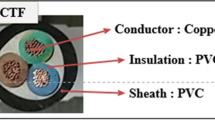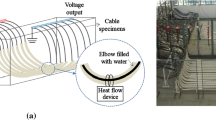Abstract
The ignition of four different PVC-based electric cables was studied using cone calorimeter and the influence of the charring phenomenon on ignition was investigated. The thermophysical and optical properties of the sheaths before decomposition were measured. The kinetics of charring was studied by photogrammetry. It was shown that charring occurs for three cables before ignition at heat flux lower than 45 kW/m2. The lower is the heat flux, the higher is the char amount at ignition. In spite of the char formation, it was observed that the time-to-ignition of the cables can be properly calculated using the well-known Quintiere’s equation, considering an apparent temperature of ignition. This apparent temperature at ignition was found in the range 312°C to 349°C for the four electric cables.










Similar content being viewed by others
Abbreviations
- c:
-
Specific heat (J/(kg.K))
- CHF:
-
Critical heat flux (kW/m2)
- D:
-
Thermal diffusivity (m2/s)
- h:
-
Heat exchange coefficient (W/(m2 K))
- HF:
-
External heat flux (W/m2)
- I:
-
Spectral emittance (W m−2 m−1)
- k:
-
Thermal conductivity (W/(m K))
- L:
-
Sample thickness (m)
- R:
-
Reflectance (-)
- \(T_{0}\) :
-
Initial temperature (K)
- Tig :
-
Surface temperature at ignition (K)
- Tp :
-
Temperature of the first peak of mass loss rate (K)
- TTI:
-
Time-to-ignition (s)
- t:
-
Time (s)
- tchar :
-
Time for char appearance (s)
- TRP:
-
Thermal Response Parameter (kW s1/2 m−2)
- Vchar :
-
Char volume (cm3)
- XLPE:
-
Crosslinked polyethylene
- \(\alpha\) :
-
Absorbance (-)
- \(\varepsilon\) :
-
Emissivity (-)
- \(\lambda\) :
-
Wavelength (m)
- \(\sigma\) :
-
Stefan-Boltzmann constant (5.67 × 10−8 Wm−2 K−4)
- \(\rho\) :
-
Density (kg/m3)
References
Zavaleta P, Hanouzet R, Beji T (2019) Improved assessment of fire spread over horizontal cable trays supported by video fire analysis. Fire Technol 55:233–255
Huang X, Nakamura Y (2020) A review of fundamental combustion phenomena in wire fires. Fire Technol 56:315–360
Huang X, Zhu H, Peng L, Zheng Z, Zeng W, Bi K, Cheng C, Chow W (2019) Thermal characteristics of vertically spreading cable fires in confined compartments. Fire Technol 55:1849–1875
McGrattan K, Lock A, Marsh N, Nyden M, Price M, Morgan AB, Galaska M, Schenck K (2010) Cable heat release, ignition, and spread in tray installations during fire (Christifire) Volume 1: Horizontal Trays, United States Nuclear Regulatory Commission, Washington DC
Coaker A, Hirschler M, Shoemaker C (1992) Rate of heat release testing for vinyl wire and cable materials with reduced flammability and smoke full-scale cable tray tests and small-scale tests. Fire Saf J 19:19–53
Rhodes BT, Quintiere JG (1996) Burning rate and flame heat flux for PMMA in a cone calorimeter. Fire Saf J 26:221–240
Quintiere JG (2001) The effects of angular orientation on flame spread over thin materials. Fire Saf J 36:291–312
Lyon R, Quintiere J (2007) Criteria for piloted ignition of combustible solids. Combust Flame 151:551–559
Schartel B, Hull R (2007) Development fire-retarded materials—interpretation of cone calorimeter data. Fire Mater 31:327–354
Hopkins D Jr, Quintiere JG (1996) Material fire properties and predictions for thermoplastics. Fire Saf J 26:241–268
Bal N, Rein G (2011) Numerical investigation of the ignition delay time of a translucent solid at high radiant heat fluxes. Combust Flame 158:1109–1116
Boulet P, Parent G, Acem Z, Collin A, Försth M, Bal N, Rein G, Torero J (2014) Radiation emission from a heating coil or a halogen lamp on a semitransparent sample. Int J Therm Sci 77:223–232
Girods P, Bal H, Biteau H, Rein G, Torero J (2011) Comparison of pyrolysis behavior results between the cone calorimeter and the fire propagation apparatus heat sources. Fire Saf Sci 10:889–901
Sonnier R, Bokobza L, Concha-Lozano N (2015) Influence of multiwall carbon nanotube (MWCNT) dispersion on ignition of poly(dimethylsiloxane)–MWCNT composites. Polym Adv Technol 26:277–286
Sonnier R, Ferry L, Gallard B, Boudenne A, Lavaud F (2015) Controlled emissivity coatings to delay ignition of polyethylene. Materials 8:6935–6949
Oztekin E, Crowley S, Lyon R, Stoliarov S, Patel P, Hull R (2012) Sources of variability in fire test data: a case study on poly(aryl ether ether ketone) (PEEK). Combust Flame 159:1720–1731
Meinier R, Sonnier R, Zavaleta P, Suard S, Ferry L (2018) Fire behavior of halogen-free flame retardant electrical cables with the cone calorimeter. J Hazard Mater 342:306–316
Gong T, Xie Q, Huang X (2018) Fire behaviors of flame-retardant cables part I: decomposition, swelling and spontaneous ignition. Fire Saf J 95:113–121
Zavaleta P, Suard S, Audouin L (2019) Cable tray fire tests with halogenated electric cables in a confined and mechanically ventilated facility. Fire Mater 43:543–560
Siemon M, Riese O, Forell B, Krönung D, Klein-Heßling W (2019) Experimental and numerical analysis of the influence of cable tray arrangements on the resulting mass loss rate and fire spreading. Fire Mater 43:497–513. https://doi.org/10.1002/fam.2689
Decimus A, Sonnier R, Zavaleta P, Suard S, Ferry L (2019) Study of gases released under incomplete combustion using PCFC–FTIR. J Therm Anal Calorim 138:753–763
Boulet P, Parent G, Acem Z, Rogaume T, Fateh T, Zaida J, Richard F (2012) Characterization of the radiative exchanges when using a cone calorimeter for the study of the plywood pyrolysis. Fire Saf J 51:53–60
Beyler C , Hirschler M (2002) Thermal decomposition of polymers, SFPE handbook of Fire Protection Engineering, 3rd edn, Section 1, Chapter 7. ISBN: 087765-451-4
Courty L, Garo JP (2017) External heating of electrical cables and auto-ignition investigation. J Hazard Mater 321:528–536
Tewarson A (2002) Generation of heat and chemical compound in fires, SFPE handbook of fire protection engineering, ISBN:087765-451-4, Third edition, Section three, Chapter 4
Acknowledgments
Dominique Lafon-Pham and Robert Lorquet are acknowledged for their help in performing photogrammetry analysis. Gilles Parent from LEMTA (University of Lorraine) is acknowledged for the emissivity measurements. Electricité de France (EdF) sponsored this work through a bilateral partnership with IRSN and Abdenour Amokrane is fully acknowledged for his fruitful discussion.
Author information
Authors and Affiliations
Corresponding author
Additional information
Publisher's Note
Springer Nature remains neutral with regard to jurisdictional claims in published maps and institutional affiliations.
Supplementary Information
Below is the link to the electronic supplementary material.
Supplementary file1 (MP4 24614 kb)
Rights and permissions
About this article
Cite this article
Meinier, R., Fellah, M., Sonnier, R. et al. Ignition and Charring of PVC-Based Electric Cables. Fire Technol 58, 689–707 (2022). https://doi.org/10.1007/s10694-021-01168-0
Received:
Accepted:
Published:
Issue Date:
DOI: https://doi.org/10.1007/s10694-021-01168-0




